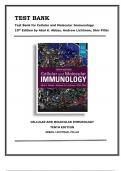Exam (elaborations)
TEST BANK Cellular and Molecular Immunology 10th Edition Abul K. Abbas, Andrew H. Lichtman, Shiv Pillai, 9780323757485 (CHAPTERS 1-21)
- Course
- Institution
TEST BANK Cellular and Molecular Immunology 10th Edition Abul K. Abbas, Andrew H. Lichtman, Shiv Pillai, 9780323757485 (CHAPTERS 1-21) Cellular and Molecular Immunology Tenth Edition Test Bank / Cellular and Molecular Immunology, 10th Edition Test Bank / Test Bank Cellular and Molecular Immunology...
[Show more]



